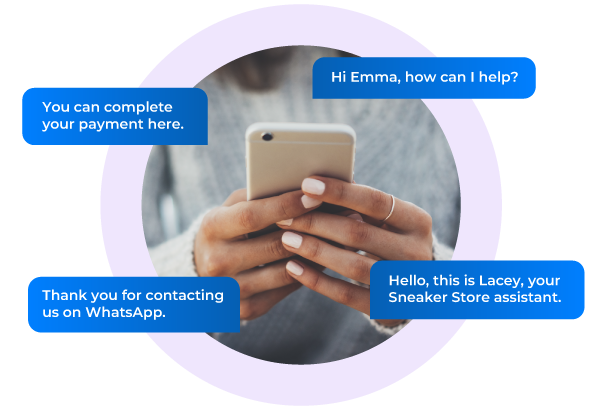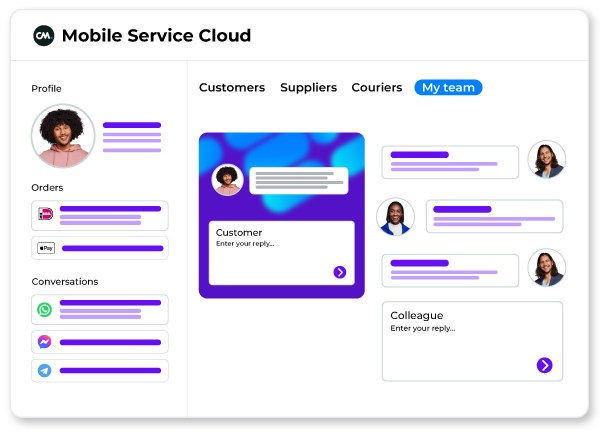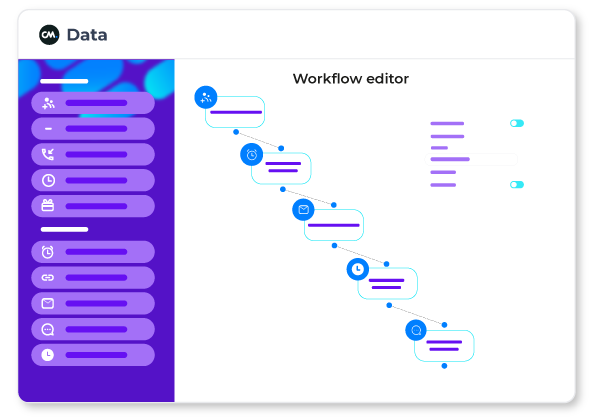- Customer KPIs to Improve Customer Experience
- Why Does It Matter?
- What Are Customer KPIs?
- 4 Customer Service KPIs to Track
- Operational KPIs to Improve Business Performance
- Why Does It Matter?
- What Are Operational KPIs?
- 4 Operational KPIs for Customer Service
- How to Monitor KPIs in Mobile Service Cloud
To further improve services and products, customer service software is helpful. Besides offering an omnichannel service journey for your customers and an efficient way of working for your team, these tools also generate new data sources. Use this data to set the right KPIs and improve not only customer experience, but also business efficiency and effectiveness. Let's dive into 8 metrics to measure customer service, divided into Customer KPIs and Operational KPIs.
Customer KPIs to Improve Customer Experience
Oftentimes companies think of improving the operational side of customer service but forget the most important part: servicing customers. Focus on both customer- and business goals to reach the best customer service results.
Why Does It Matter?
First, let's talk about why you should care. Improving your customer service with new technology is not a solution by itself. It's an enabler. You still need to improve how you interact with your customers. These KPIs will give insight into your current interactions and will be the basis of your improvement. A great customer service can help you to:
Win from competition. Great customer experience can make the difference.
Increase revenue. Over 40% of consumers would be willing to pay more for greater experience (PWC, 2018)
Influence purchasing decisions. 73% of all people see customer experience as an important factor in their purchasing decisions (PWC, 2018)
What Are Customer KPIs?
Customer KPIs are measurable metrics used to determine performance, specifically to optimize customer experience. These KPIs indicate whether you meet customer's expectations. As expectations are different for every customer and change constantly, it's essential to analyze customer data. Gather data and feedback to understand what your customers want.
Predominantly, customer expectations of service can be divided into three categories (McKinsey, 2019):
Speed and convenience, including responsiveness, processing time, and needs-based service.
Reliability and transparency, defined as availability and proactive outreach and communication.
Interaction and care, consisting of personal attention, empathy, clarity, and friendliness. Adding the human touch.
From these three categories, we derived four measurable metrics that can be used to improve customer experience: speed, availability, effectiveness and friendliness. We'll show you how to calculate and use these KPIs.
4 Customer Service KPIs to Track
Speed
You snooze, you lose. A famous saying, but truer than ever. Especially for Customer Service. When customers have a question, they expect an immediate response. Moreover, 75% of customers perceive ‘fast response times’ as the most important attribute of good customer service (SuperOffice, 2021). To manage expectations, you can implement automatic responses. Include an indication of when you will respond. Or make use of a chatbot to answer frequently asked questions.

How to measure?
The time between the moment a customer sends a question or query and the moment the customer service team responds, is called ‘response time'. Measure response times to know how fast customers are being helped.
Ask yourself the following questions: What is the average response time? How does it differ per channel?
What to aim for?
Set realistic goals per channel. For example, customers expect a less immediate response via email than via a live chat. Measure what the current response times are and then set goals to optimize.
Availability
Customers expect a response, whenever, wherever they are facing an issue or have a question. Whether it's early in the morning or in the middle of the night. Make sure your customer service team is reliable.
How to measure?
Measure the availability of your team to outperform expectations. For this KPI, do not take into account chatbot availability. Focus on the effective availability of the agents. How much traffic is handled during customer service hours? Are you using live chat as a channel? Calculate the live chat availability. You can define ‘coverage’ and ‘presence'. Look at how many page views are covered during opening hours to measure ‘coverage'. Online presence, such as live chat availability, can be measured based on page views with online presence.
What to aim for?
Define goals for your team, based on your current performance. See if 100% coverage is possible, or set your goal to 80% for example.
Effectiveness
Every customer wants to be helped effectively. A fast answer, but also an extensive enough response to move forward. One of the frustrations customers have is unnecessarily back-and-forth. Avoid playing ping pong with your customers, but try to answer their questions as clear, but also as thoroughly, as possible. By measuring Effectivity, you can tell how effective your service team is in solving problems and helping customers along their journey.
How to measure?
Effectivity is a relative KPI. It's necessary to set a threshold of what is considered effective. After setting that standard, you can start making calculations, such as an ‘effectivity rating'.
Calculate the Effectivity Rating by dividing the number of effective answers by the total amount of answers. Then, take this percentage of the total amount of answers. The score you'll get is your Effectivity Rating.
What to aim for?
Aim for the highest effectiveness possible. By setting standards, you can play around with what rating should be your aim. Base your goal on your current data. Is your Effectivity Rating a 6.7 at the moment? Then an 8 would be an appropriate goal.
Friendliness
A personal response from a friendly customer representative is appreciated by any customer. Don't forget the customer service team heavily impacts how your business is perceived. Besides, the majority of purchase decisions happen unconsciously. A great way to impact the unconscious, is by offering a great customer experience. That's why friendliness is key
How to measure?
Friendliness is not a predefined metric. It really depends on how customers feel. To measure this, you can ask customers about their experience. Consider using a post-service survey, where customers can rate their contact. Or simply add smileys in the chat, where customers can choose the one matching their feelings.
What to aim for?
Happy customers should always be the goal. By being friendly, you can positively impact customer satisfaction.
Operational KPIs to Improve Business Performance
It is evident (measuring) satisfied customers should be the top priority of every customer service department. However, offering a great customer experience is only possible if your customer service department processes are in order. Optimizing business processes will positively impact the Customer KPIs as well. Set Operational KPIs to help the customer service team to become even better
Why Does It Matter?
Improving your customer service level is only possible with an aligned and focused team. As customers’ expectations of ‘good service’ change constantly, every customer service manager should make sure their team is constantly streamlined and focuses on the right KPIs. Setting metrics can help you to discover potential bottlenecks that prevent maintaining a sufficient service and resolve time.
What Are Operational KPIs?
With Operational KPIs you measure the efficiency and effectiveness of your customer service department and its employees. These metrics indicate whether your department is operating at a sufficient level to optimally manage all incoming service requests.
A well-performing customer service department:
Is consistent in providing quality customer service
Has a customer-driven mindset
Is flexible and responds fast to change
To meet the above goals, you should keep track of four metrics that can be used to measure and improve efficiency. These are: productivity, engagement, contribution, and prevention.
4 Operational KPIs for Customer Service
Productivity
Tracking the productivity of the team is a no-brainer for every customer service manager. The reason is simple: the more productive your agents, the more service requests can be handled in less time. Reduce costs by increasing productivity. Keep in mind, that not only the quantity but also the quality of service should be measured. Delivering quality service can only be achieved with happy employees.
How to measure?
Measuring productivity can be done with several methods. Let’s highlight the most important metrics top service organizations use daily.
Conversation metrics. Including several real-time metrics giving an overview of the workload of the team. These include the total conversation volume, the number of conversations per customer service representative, and current open conversations.
Average First Response Time (FRT). This is the time between when the service request is sent, and the agent responds. A high FRT indicates employees respond faster to your customers. You can calculate this via ‘time of first response – time of customer request’. This KPI, called ‘response time’ is also part of the Customer KPIs, as this heavily impacts customer experience.
Average Resolution Time (ART). This is the average total time taken by your team to resolve one support ticket. This is important, because the shorter customers are waiting for their request to be resolved, the higher your customer satisfaction and employee productivity. Win-win!
Employee happiness. Continuously monitor the happiness of your customer service team. Ask regularly if your employees feel they are being heard and are satisfied with their work. Also, low absenteeism and turnover are clear indicators of a happy workforce.
What to aim for?
Find the right balance. Aim for the highest productivity, while keeping the team happy. Make sure your team is not overworked. Dissatisfied agents have an enormous impact on your service quality.
Engagement
Delivering quality customer service also concerns the level of accessibility of your department. If customers have a hard time reaching your department, frustration will ensue. To have a good understanding of your overall customer satisfaction and the quality of your service, keep track of the need your customers have for service.

It’s simple: the more accessible your customer service is for your customers, the happier the customers and the more data can be gathered. More engagement will lead to more insights. Besides, if your customers can't reach you, how do you know if they are happy? This category of metrics focuses on customer engagement with your service department.
How to measure?
Have a critical look at your website and check whether it is easy to contact the service department. Is the support page prominently featured on the menu or in the website footer? Has the support page a good position in search engines? Does your support page list the ways to contact your business clearly? To support this with data, keep track of the percentage of total website traffic that visits the support page. If this percentage drops significantly over time, that is a clear indicator something is wrong with your website. The same goes for the percentage of support page visitors that contact your service department.
Within a customer service tool, you can measure the ratio of Live Chat engagement. Compare how often the Live Chat button is shown with how often a chat is started.
What to aim for?
Aim for the highest possible engagement ratios. The easier it is for your customers to contact your service department, the more accurate your service quality can be measured and optimized.
Contribution
Your team not only exists to resolve issues and complaints, but you also provide your customers with a way to ask general questions. Moreover, customer service can remove doubts of potential customers. If executed well, your customer service team can have a significant direct effect on the bottom line. Keep track of the number of (micro-) conversions generated from conversations with your customers.
How to measure?
Measuring the direct impact of your department on the bottom line is easier said than done. Without sophisticated customer service software in place, it’s impossible to track the (micro-) conversions that take place because of a conversation with a representative.
Ensure your service department is connected to your order system or set up qualitative reporting. Set the right tracking for your conversions. Whether that's consent giving, a digital signature or the download of a paper after contact. Collect your customer data within one central location, such as a Customer Data Platform. When someone contacts your service team, this info is stored in the CDP.

If the same person (or organization) then converts, this will show in your reporting. This connection lets you measure the number of service requests that resulted in a conversion but will also show other relevant information for your business, such as average order value. Don't forget to keep track of the costs. To continuously measure the total team operating costs and the cost per conversation. Calculate cost per conversation by dividing the total costs by the total number of conversations.
What to aim for?
It is a no-brainer to aim for the highest gross profit generated by your customer service department. However, not every conversation results in a direct sale, but every conversation can result in higher customer satisfaction which can result in repeat purchases. Good customer service software is necessary to measure the generated sales of customer service requests.
Prevention
The Prevention KPI tells you how your customer service team helps reducing complaints. How you handle complaints can significantly affect overall customer satisfaction. Handling complaints well is a great opportunity to convert a dissatisfied to a satisfied customer. Therefore, it is important to keep track of such metrics. But how? Let’s find out.
How to measure?
Good customer service software can tag specific conversations. Keep track of the number of complaints your business receives with a custom tag. In this way, it is possible to measure the total amount of complaints as well as the total amount of resolved complaints.
A more sophisticated metric is the First Contact Resolution Rate. This metric is all about the number of conversations in which the customer’s issue is resolved with the first response. Aiming for a high FCRR, you focus on resolving complaints as fast as possible. You can calculate the FCRR by dividing the total number of support issues resolved on the first contact with the total number of FCR-tagged conversations.
Of course, not all queries can be resolved in the first response. Sometimes the customer makes a mistake in their query. This is where tags come in handy. Tagging these conversations will keep your data clean.
What to aim for?
Again, this is a tricky one. If you urge your employees to focus on maintaining a low number of replies, they will ignore or close conversations prematurely. Which will cause frustrations as well. They may also choose to handle complex issues less frequently. This negatively affects your service quality.
How to Monitor KPIs in Mobile Service Cloud
Setting the right KPIs for your customer service team will give focus and improve performance. Think of both Customer KPIs as Operational KPIs. A good set of KPIs is like the northern star. It will guide customer service representatives in the right direction. Besides, great customer service will positively impact customer experience. Happy customers can turn into loyal customers and are more likely to convert. This also applies to B2B. Everyone wants to be helped effectively.
Want to learn how you can monitor KPIs in our customer service software Mobile Service Cloud? Watch the demo video and understand how you can optimize your service based on data.
By using great customer service software, you can measure performance by set KPIs within a dashboard. Within Mobile Service Cloud, all mentioned KPIs are tracked automatically.
